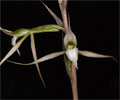|
|
|
|
|
| |
Established Seedlings of
Eltroplectris calcarata 'MC7272' × 'MC7270' |
|
| |
|
|
| |
| Number: |
TN8346 |
| Name: |
Eltroplectris calcarata 'MC7272' × 'MC7270'
|
| Type: |
outcross (What's that?) |
|
Seed Donor: |
Troy C. Meyers
|
|
Click to Enlarge

Pod Parent Flower |
Click to Enlarge

Pod Parent Blooming Plant |
Click to Enlarge

Pollen Parent Flower |
|
|
|
| |
Comments: Pod parent plant: One of the offspring from our TN6307 effort of 2008.
Pollen parent plant: One of the offspring from our TN6942 effort of 2010.
For additional origin/habitat information supplied courtesy of
Charles and Margaret Baker, see further below, near the bottom of this page.
|
Temperatures we attempt to use in the lab & greenhouse:
| For Species: |
|
Spring, Summer, Autumn: days average 87°F, nights 76°F; best fit is Warm 90-70°F
(Source:
Baker's Web OSC) |
| For Species: |
|
Winter: days average 87°F, nights 76°F; best fit is Warm 90-70°F
(Source:
Baker's Web OSC) |
|
About the name...
| Etymology of |
calcarata |
|
From Latin "calcaratus" spurred, having a spur.
(Source:
Mayr & Schmucker 1998) |
| Etymology of |
Eltroplectris |
|
From latinized Greek "plektron" spur. The meaning of "eltro" is not clear.
(Source:
Mayr & Schmucker 1998) |
| Pronunciation of |
Eltroplectris |
|
el-troe-PLEK-tris
(Source:
Hawkes 1978) |
|
If you would like to direct someone to this web page, please copy and paste this URL into your email:
http://troymeyers.com/d?128346
ESTABLISHED SEEDLINGS
of these are not currently available.
We do not have any unsold in the greenhouse, but may offer them in the future.
Click here to see if we have flasks available.
|
|
|
| |
The origin/habitat information below is supplied courtesy of Charles and Margaret Baker
The following information is based on the name of the plant provided by the donor, and assumes that the name is correct. If the plant has been misidentified, then the following information may not be correct.
This text is copyrighted by the Bakers and may not be reproduced without permission.
ORIGIN/HABITAT: This often-named terrestrial orchid is found from southern
Florida through the Caribbean to South America in Brazil and Colombia.
Plants in Florida were found in Dade County in a dense hammock in 1905 and
Highlands County in 1936 where they were growing in a low, moist hammock.
These swampy forests have given way to progress, and it is not known
whether or not plants still survive in out-of-the-way locations in
Florida. Plants are said to be common in the Bahama Islands where they
grow in rather dense coppices, reportedly blooming January to March. In
Puerto Rico this orchid is uncommon but is known from the western part of
the island where it grows in thick humus in the shade of moist to wet
montane forests at 1000-2950 ft. (300-900 m).
More about this information and the Bakers...
|
|
|
| |
|
|
|